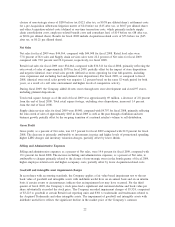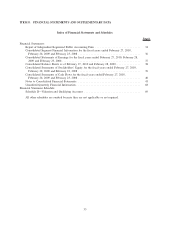Albertsons 2010 Annual Report Download - page 33
Download and view the complete annual report
Please find page 33 of the 2010 Albertsons annual report below. You can navigate through the pages in the report by either clicking on the pages listed below, or by using the keyword search tool below to find specific information within the annual report.approximately $1,101, net of the discount of $191, and $1,142, net of the discount of $223, as of February 27,
2010 and February 28, 2009, respectively. As of February 27, 2010, each 25 basis point change in the discount
rate would impact the self-insurance liabilities by approximately $1.
Benefit Plans
The Company sponsors pension and other postretirement plans in various forms covering substantially all
employees who meet eligibility requirements. The determination of the Company’s obligation and related
expense for Company-sponsored pension and other postretirement benefits is dependent, in part, on
management’s selection of certain actuarial assumptions used in calculating these amounts. These assumptions
include, among other things, the discount rate, the expected long-term rate of return on plan assets and the
rates of increase in compensation and healthcare costs. The discount rate is based on current investment yields
on high-quality fixed-income investments. The expected long-term rate of return on plan assets is based on the
historical experience of the Company’s investment portfolio and the projected returns by asset category. Over
the 10-year period ended February 27, 2010 and February 28, 2009, the average rate of return on plan assets
was approximately 4 percent and 2 percent, respectively. The decrease in the 10-year average rate of return on
pension assets was due to the unprecedented decline in the economy and continuing credit market turmoil
during fiscal 2009. The Company expects that the markets will eventually recover to the assumed long-term
rate of return of 8 percent. In accordance with accounting standards, actual results that differ from the
Company’s assumptions are accumulated and amortized over future periods and, therefore, affect expense and
obligations in future periods.
During fiscal 2010, the Company contributed $126 to its pension plans and $6 to its postretirement benefit
plans, and expects to contribute $81 to its pension plans and $8 to its postretirement benefit plans in fiscal
2011.
For fiscal 2011, each 25 basis point reduction in the discount rate would increase pension expense by
approximately $8 and each 25 basis point reduction in expected return on plan assets would increase pension
expense by approximately $4. Similarly, for postretirement benefits, a 100 basis point change in the healthcare
cost trend rate would impact the accumulated postretirement benefit obligation as of the end of fiscal 2010 by
approximately $10 and the service and interest cost by $1 in fiscal 2011. Although the Company believes that
its assumptions are appropriate, the actuarial assumptions may differ from actual results due to changing
market and economic conditions, higher or lower withdrawal rates and longer or shorter life spans of
participants.
In addition, the Company contributes to various multi-employer pension plans under collective bargaining
agreements, primarily defined benefit pension plans. These plans generally provide retirement benefits to
participants based on their service to contributing employers. Based on available information, the Company
believes that some of the multi-employer plans to which it contributes are underfunded. Company contributions
to these plans are likely to continue to increase in the near term. However, the amount of any increase or
decrease in contributions will depend on a variety of factors, including the results of the Company’s collective
bargaining efforts, investment return on the assets held in the plans, actions taken by the trustees who manage
the plans, and requirements under the Pension Protection Act of 2006 and Section 412(e) of the Internal
Revenue Code of 1986, as amended (the “Internal Revenue Code”). Furthermore, if the Company were to exit
certain markets or otherwise cease making contributions to these plans at this time, it could trigger a
withdrawal liability that would require the Company to fund its proportionate share of a plan’s unfunded
vested benefits. The Company contributed $143, $147 and $142 to these plans for fiscal 2010, 2009 and 2008,
respectively.
Income Taxes
The Company’s current and deferred tax provision is based on estimates and assumptions that could materially
differ from the actual results reflected in its income tax returns filed during the subsequent year and could
significantly affect the effective tax rate and cash flows in future years.
27
























